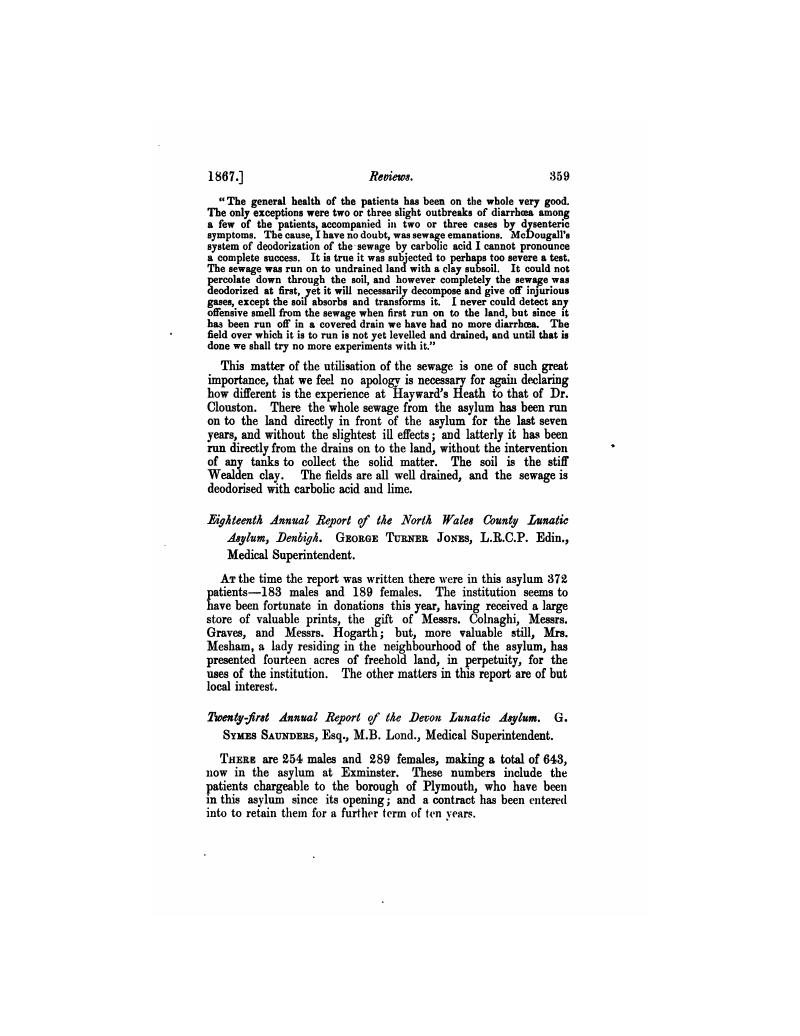No CrossRef data available.
Article contents
Twenty-first Annual Report of the Devon Lunatic Asylum. by G. Symessaunders, Esq., M.B. Lond. Medical Superintendent.
Published online by Cambridge University Press: 19 February 2018
Abstract

- Type
- Part II.—Reviews
- Information
- Copyright
- Copyright © Royal College of Psychiatrists, 1867
References
“1. An observation room was set apart for the reception of all patients attacked with diarrhoea and suspected cases.Google Scholar
“2. Two dormitories at the detached male new house were converted into a cholera ward. A temporary staircase, external to the building, was erected, and internal communication with other parts of the building was cut off by a partition. All cases of decided cholera were at once sent to this ward.Google Scholar
“3. All closets and utensils were thoroughly disinfected, and cleansed twice a day, ottener if necessary.Google Scholar
“4. All excreta, vomit, as well as dejections, were received into vessels containing chloride of lime, carbolate of lime, or Sir W. Burnett's fluid. When passed on the floor they were at once covered with disinfectants, and removed without delay. A deep trench was dug in which the excreta were buried.Google Scholar
“5. The attendants were directed to watch the patients narrowly, and report to the superintendent, or assistant medical officer, any patient seen going to the closet more than once a day, also to report the first symptoms of diarrhoea or vomiting.Google Scholar
“6. All linen or mattresses tainted with the discharge to be burnt.Google Scholar
“7. The hands of all attendants on the sick to be scrupulously cleaned, whenever they have become soiled by ‘rice water,’ by washing in ‘Condy's fluid.’Google Scholar
“8. Special attention to be directed to the feeding and clothing of all the patients.Google Scholar
“9. An extra allowance of meat was ordered for every patient in the asylum, and other extras according to circumstances.Google Scholar
∗ " 10. Convalescents to be kept some time separate from the healthy patients.Google Scholar
“11. The friends of patients were not allowed to visit the asylum.Google Scholar
“12. The patients in the ward where the disease first broke out were removed to No. 6 ward, and the patients in that ward were accommodated in the chapel, which was fitted up as a dormitory containing thirty-six beds. Every gallery, day room, and dormitory, with closets, &c., were thoroughly whitewashed and disinfected throughout the asylum.Google Scholar
“13. A temporary cholera hospital for the women, according to a plan submitted to the visitors by the superintendent, was erected. It consists of a wooden building 60 by 20; 12 feet to the eaves, and 25 feet to the centre, accommodating twenty patients, allowing to each patient 1000 cubic feet. In design and construction it is similar to the military wooden hut or hospital.Google Scholar
“14. A qualitative and quantitative analysis of the water was made by Professor Voelcker, who reported that it was ‘unusually pure and whole-some drinking water,’ ‘and unusually pure as regards organic impurities.’”Google Scholar





eLetters
No eLetters have been published for this article.